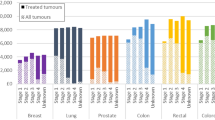Abstract
Prior to the German reunification, cancer survival was much lower in East than in West Germany. We compare cancer survival between Eastern and Western Germany in the early twenty-first century, i.e. the second decade after the German reunification. Using data from 11 population-based cancer registries covering a population of 33 million people, 5-year age-standardized relative survival for the time period 2002–2006 was estimated for the 25 most common cancers using model-based period analysis. In 2002–2006, 5-year relative survival was very similar for most cancers, with differences below 3 % units for 20 of 25 cancer sites. Larger, statistically significant survival advantages were seen for oral cavity, oesophagus, and gallbladder cancer and skin melanoma in the West and for leukemia in the East. Our study shows that within two decades after the assimilation of political and health care systems, the former major survival gap of cancer patients in Eastern Germany has been essentially overcome. This result is encouraging as it suggests that, even though economic conditions have remained difficult in Eastern Germany, comparable health care provision may nevertheless enable comparable levels of cancer survival within a relatively short period of time.
Similar content being viewed by others
References
Brenner H, Francisci S, de Angelis R, Marcos-Gragera R, Verdecchia A, Gatta G, et al. Long-term survival expectations of cancer patients in Europe in 2000–2002. Eur J Cancer. 2009;45(6):1028–41.
Verdecchia A, Francisci S, Brenner H, Gatta G, Micheli A, Mangone L, et al. Recent cancer survival in Europe: a 2000–02 period analysis of EUROCARE-4 data. Lancet Oncol. 2007;8(9):784–96.
Möhner M, Stabenow R, Eisinger B. Atlas der Krebsinzidenz in der DDR 1961–1989. Munich: Urban and Fischer; 1999.
Gondos A, Holleczek B, Arndt V, Stegmaier C, Ziegler H, Brenner H. Trends in population-based cancer survival in Germany: to what extent does progress reach older patients? Ann Oncol. 2007;18(7):1253–9.
Stabenow R, Wilsdorf-Köhler H, Neumeyer-Gromen A, Streller B. Krebs in Mecklenburg–Vorpommern 2007–2008 (Landesbericht). Berlin: Gemeinsames Krebsregister; 1/2011.
Hiripi E, Gondos A, Emrich K, Holleczek B, Katalinic A, Luttmann S, et al. Survival from common and rare cancers in Germany in the early 21st century. Ann Oncol. 2011;23(2):472–9.
Brenner H, Hakulinen T. Up-to-date and precise estimates of cancer patient survival: model-based period analysis. Am J Epidemiol. 2006;164(7):689–96.
Brenner H, Hakulinen T. Up-to-date long-term survival curves of patients with cancer by period analysis. J Clin Oncol. 2002;20(3):826–32.
Brenner H, Soderman B, Hakulinen T. Use of period analysis for providing more up-to-date estimates of long-term survival rates: empirical evaluation among 370,000 cancer patients in Finland. Int J Epidemiol. 2002;31(2):456–62.
Corazziari I, Quinn M, Capocaccia R. Standard cancer patient population for age standardising survival ratios. Eur J Cancer. 2004;40(15):2307–16.
Ederer F, Heise H. Instructions to IBM 650 programmers in processing survival computations. Bethesda: National Cancer Institute; 1959.
Robert Koch Institute. 20 Jahre nach dem Fall der Mauer: Wie hat sich die Gesundheit in Deutschland entwickelt?. Berlin: Robert Koch Institute; 2010.
Razum O, Altenhoner T, Breckenkamp J, Voigtlander S. Social epidemiology after the German reunification: east vs. West or poor vs. rich? Int J Public Health. 2008;53(1):13–22.
Coleman MP, Rachet B, Woods LM, Mitry E, Riga M, Cooper N, et al. Trends and socioeconomic inequalities in cancer survival in England and Wales up to 2001. Br J Cancer. 2004;90(7):1367–73.
Rachet B, Ellis L, Maringe C, Chu T, Nur U, Quaresma M, et al. Socioeconomic inequalities in cancer survival in England after the NHS cancer plan. Br J Cancer. 2010;103(4):446–53.
Bastiaannet E, de Craen AJ, Kuppen PJ, Aarts MJ, van der Geest LG, van de Velde CJ, et al. Socioeconomic differences in survival among breast cancer patients in the Netherlands not explained by tumor size. Breast Cancer Res Treat. 2011;127(3):721–7.
Lagerlund M, Bellocco R, Karlsson P, Tejler G, Lambe M. Socio-economic factors and breast cancer survival—a population-based cohort study (Sweden). Cancer Causes Control. 2005;16(4):419–30.
Berrino F, Micheli A, Sant M, Capocaccia R. Interpreting survival differences and trends. Tumori. 1997;83(1):9–16.
Brenner H, Hakulinen T. Population-based monitoring of cancer patient survival in situations with imperfect completeness of cancer registration. Br J Cancer. 2005;92(3):576–9.
Kogevinas M, Porta M. Socioeconomic differences in cancer survival: a review of the evidence. IARC Sci Publ. 1997;138:177–206.
Acknowledgments
This study was supported by the German Cancer Aid (Deutsche Krebshilfe) Grant No. 108257.
Conflict of interest
The authors declare that they have no conflict of interest.
Author information
Authors and Affiliations
Consortia
Corresponding author
Additional information
Members of the GEKID Cancer Survival Working Group are listed in Appendix A.
Appendix A
Appendix A
Members of the GEKID Cancer Survival Working Group: Karla Geiss, Martin Meyer (Cancer Registry of Bavaria), Andrea Eberle, Sabine Luttmann (Cancer Registry of Bremen), Roland Stabenow (Cancer Registry of Berlin and the New Federal States), Stefan Hentschel, Alice Nennecke (Cancer Registry of Hamburg), Joachim Kieschke, Eunice Sirri (Cancer Registry of Lower Saxony), Bernd Holleczek (Saarland Cancer Registry), Katharina Emrich (Cancer Registry of Rhineland-Palatinate), Hiltraud Kajüter, Volkmar Mattauch (Cancer Registry of North Rhine-Westphalia), Alexander Katalinic (Cancer Registry of Schleswig-Holstein), Klaus Kraywinkel (Robert Koch Institute, Berlin), Hermann Brenner, Adam Gondos, Lina Jansen (German Cancer Research Center).
Rights and permissions
About this article
Cite this article
Jansen, L., Gondos, A., Eberle, A. et al. Cancer survival in Eastern and Western Germany after the fall of the iron curtain. Eur J Epidemiol 27, 689–693 (2012). https://doi.org/10.1007/s10654-012-9723-5
Received:
Accepted:
Published:
Issue Date:
DOI: https://doi.org/10.1007/s10654-012-9723-5




